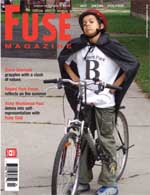
|
Lorna Mills and Sally McKay
Digital Media Tree this blog's archive OVVLvverk Lorna Mills: Artworks / Persona Volare / contact Sally McKay: GIFS / cv and contact |
View current page
...more recent posts

I'm on the editorial committee for FUSE Magazine. There is a launch and screening tomorrow night at Cinecycle. It's gonna be good!
Launch for Volume 29, Issue 4
November 15, 2006
7 p.m. sharp
$10
FUSE launches 'Mobilizing Our Interests' with Regent Park TV. Featuring film screenings by Regent Park Focus and the Balata Film Collective (presented by Vicky Moufawad-Paul)
At CINECYCLE (129 Spadina Ave., Toronto)
In a recent comment thread I was nattering on about neurology & consciousness, thinking I'd already covered this particular topic on the blog. But I realised I was thinking of one of my "Up & Anti-Up" columns for Kiss Machine magazine. Here is an excerpt from issue # 11
During neuroscience experiments in the 1970s, patients were poked on the arm, and asked to note the exact moment when they became consciousness of the stimulus. Brain activity was recorded. Next, the patients were poked directly on the area of the brain that had previously been stimulated. Astonishingly, the brain pokes were “noticed” significantly later than the arm pokes were. This suggested that the brain was receiving information after it was first perceived, but sending that information back in time to coincide with the moment of stimulus. Too trippy? Yes, it is, and of course a lot of people have perfectly non-spooky ways of explaining this data. But it is interesting that quantum theory has accustomed us to hearing such seemingly paranormal ideas from the mouths of credible scientists.
Daniel C. Dennett, a philosopher of consciousness, chalks up the phenomenon to a “temporal smear.” He explains that there is no fixed point when external events are registered in the mind, but rather consciousness is a process; a multi-track continuum. In his book, Consciousness Explained, he presents a more fluid model of consciousness, in which, “at any point in time there are multiple drafts of narrative fragments at various stages of editing in various places in the brain.”
Dennett also chides us (and his colleagues) for clinging to Cartesian Dualism; the old idea that consciousness resides on some separate special metaphysical plane, distinct from lumpen matter. While most people nowadays agree that the mind is a physical process (materialism), many of us still cling to a model of the Cartesian Theatre, in which our perceptions play like film on a screen, a “functional place of some sort where the items of phenomenology are projected.” But according to Dennett, “there is no such theatre, there is no such audience.” This would still require an entity separate from the system. Rather, he holds that the continuous, multiple narratives running in our brains are all there is to consciousness. Dennett’s extreme materialism is very influential, though many people feel he goes too far, especially in his 1998 article “Quining Qualia,” published in Consciousness in Modern Science, in which he denies the existence of perceptual phenomena. Nonetheless, by strictly adhering to physiology, Dennett confronts us with the idea that consciousness does not give us access to a definable external reality.